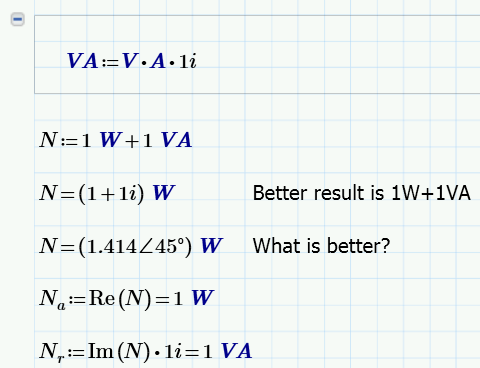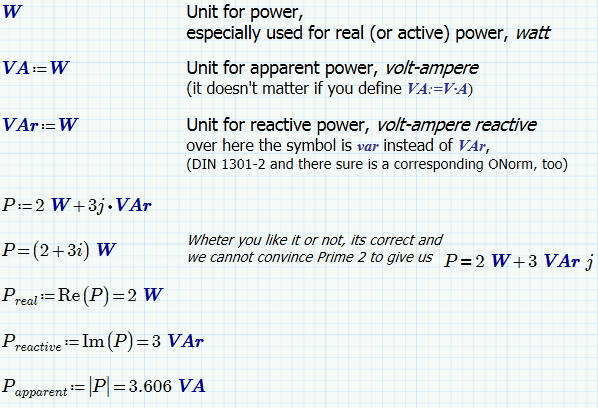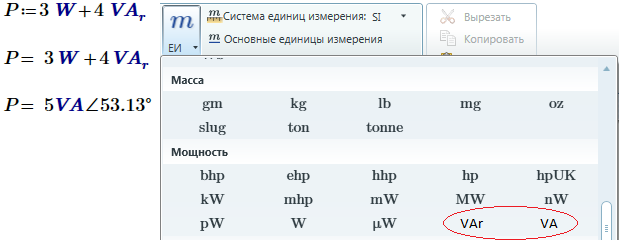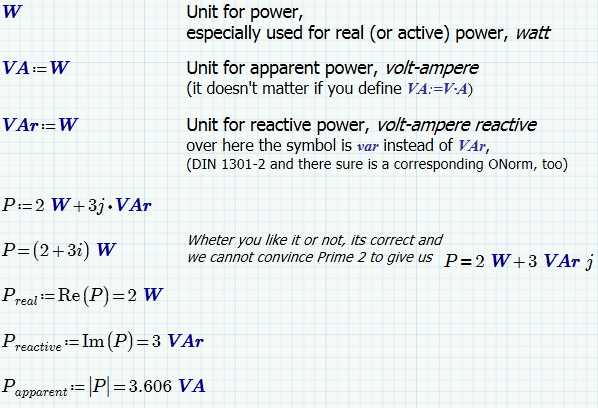Community Tip - Learn all about PTC Community Badges. Engage with PTC and see how many you can earn! X
- Subscribe to RSS Feed
- Mark Topic as New
- Mark Topic as Read
- Float this Topic for Current User
- Bookmark
- Subscribe
- Mute
- Printer Friendly Page
Mathcad Prime 2.0 - explicit function, too many digits
- Mark as New
- Bookmark
- Subscribe
- Mute
- Subscribe to RSS Feed
- Permalink
- Notify Moderator
Mathcad Prime 2.0 - explicit function, too many digits
Hello everyone!
My name is Jens, and I'm from Denmark.
I've recently changed from Mathcad 14 to Mathcad Prime 2.0. Everything is wonderful, but there is a problem with my calculations, when using the explicit function. The calculation shows up with too many digits (15), and I do know about the float function, however this is not a possible solution for me. Is there any chance that someone could help me, reducing these digits a bit?
I've attached a picture with my problem
- Jens
- Mark as New
- Bookmark
- Subscribe
- Mute
- Subscribe to RSS Feed
- Permalink
- Notify Moderator
I tried it and achieve the attached results.
Can you include your worksheet?
Norm
- Mark as New
- Bookmark
- Subscribe
- Mute
- Subscribe to RSS Feed
- Permalink
- Notify Moderator
Norm Schutzkus wrote:
I tried it and achieve the attached results.
The same here. Maybe Jens is using a different maintainance release of Prime 2.
Mine is the current M010.
But that all doesn't change the basic problem. We could apply the formatting of numeric results to symbolic results in Mathcad 15 and below, but we don't have an formatting options for symbolic results in Prime.
- Mark as New
- Bookmark
- Subscribe
- Mute
- Subscribe to RSS Feed
- Permalink
- Notify Moderator
I'll give it a look ..
I'm afraid you are right .. I'm using version F000, if that's what you asking for? Don't know if it's new or old ..
- Mark as New
- Bookmark
- Subscribe
- Mute
- Subscribe to RSS Feed
- Permalink
- Notify Moderator
As requested i attached my worksheet, but please ignore the weird language ^^.
As you can see, there is alot of places where the explicit function will give me way too many digits.
But the worst part is still the imaginary numbers in the calculations, which sometime is giving me 2 x 15 digits 😕 Even a A3 page isn't helping .. hehe
- Mark as New
- Bookmark
- Subscribe
- Mute
- Subscribe to RSS Feed
- Permalink
- Notify Moderator
Here is what your file looks like in Prime2 M010. Not much better, I guess.
For very long expressions some people here have suggested making a screenshot of the region and paste it reduced in size into the document - awful!
- Mark as New
- Bookmark
- Subscribe
- Mute
- Subscribe to RSS Feed
- Permalink
- Notify Moderator
Unfortunately there is no formatting for symbolic results implemented in Prime. Haven't heard of an improvemen in that respect in P3 either. Maybe you changed too soon from MC14 to Prime.
The float modifier would affect the total precision of your calculation and also gives sometimes different results if used with explicit (esp. the magnitude of a complex number as in your case).
BTW, your first eval looks differently if I try to reproduce.

- Mark as New
- Bookmark
- Subscribe
- Mute
- Subscribe to RSS Feed
- Permalink
- Notify Moderator
Hmmm .. That's odd .. What version do you have? This might be a workaround for me ![]()
- Mark as New
- Bookmark
- Subscribe
- Mute
- Subscribe to RSS Feed
- Permalink
- Notify Moderator
Jens Lyn wrote:
What version do you have?
As written above as an answer to Norm, who experiences the same, I am using M010.
Your F000 is the very first (therfore the F). There where two maintainance releases in the meantime (M005 and M010). In a few days we expect Prime 3.
You may try to update your Prime2 here http://www.ptc.com/product/mathcad/free-trial/download/
but rescue the license file you got during installation before.
- Mark as New
- Bookmark
- Subscribe
- Mute
- Subscribe to RSS Feed
- Permalink
- Notify Moderator
Werner Exinger wrote:
... Your F000 is the very first (therfore the F). There where two maintainance releases in the meantime (M005 and M010). In a few days we expect Prime 3 ...
Actually for Mathcad Prime 2.0 was only two service release - F000 and M010.

- Mark as New
- Bookmark
- Subscribe
- Mute
- Subscribe to RSS Feed
- Permalink
- Notify Moderator
OK, sometimes there was a M005, sometimes not. For P2 obviously not.
- Mark as New
- Bookmark
- Subscribe
- Mute
- Subscribe to RSS Feed
- Permalink
- Notify Moderator
More correct I think:

- Mark as New
- Bookmark
- Subscribe
- Mute
- Subscribe to RSS Feed
- Permalink
- Notify Moderator
Depends on how you look at it. ![]() But thank you for your comment.
But thank you for your comment.
- Mark as New
- Bookmark
- Subscribe
- Mute
- Subscribe to RSS Feed
- Permalink
- Notify Moderator
Both correct in my opinion, considering the versor symbol is just a convenient abbrevation for the multiplication with an exponential expression 
But nevertheless I would prefer the first one you suggested, too.
- Mark as New
- Bookmark
- Subscribe
- Mute
- Subscribe to RSS Feed
- Permalink
- Notify Moderator
So, will Prime 3 be able to fix the digits?
- Mark as New
- Bookmark
- Subscribe
- Mute
- Subscribe to RSS Feed
- Permalink
- Notify Moderator
As far as i know - no. There are some improvements with formatting the results of calculations but whatever I heard was about numeric results. But then, I may be wrong - perhaps the have (re)added the switch to apply the options from the numeric to the symbolic results as we are used to from Mathcad.
BTW I have converted your sheet into a pdf so you can see how the latest release of Prime 2 would do. I guess not much better if any.
- Mark as New
- Bookmark
- Subscribe
- Mute
- Subscribe to RSS Feed
- Permalink
- Notify Moderator
What a shame ..
I guess I'll have to flip the A3 page, and accept the digits ![]()
Thank you for your time - that goes for all who took the time and effort to respond ![]()
- Mark as New
- Bookmark
- Subscribe
- Mute
- Subscribe to RSS Feed
- Permalink
- Notify Moderator
One sheet for a thinking![]()

- Mark as New
- Bookmark
- Subscribe
- Mute
- Subscribe to RSS Feed
- Permalink
- Notify Moderator
I have to disagree.
Both reactive power and active power are real quantities. Neither their numerical values nor their units contain an imaginary part.
It is computationally convenient that the power is regarded as a complex number. The reactive power is then the (real) imaginary part, the apparent power is the magnitude.
One likes to use different units for apparent, reactive and active power to distinguish one frome the other (VA, VAr or var, W). Just different names, but identical to watt and no imaginary unit is involved.

- Mark as New
- Bookmark
- Subscribe
- Mute
- Subscribe to RSS Feed
- Permalink
- Notify Moderator
Werner Exinger wrote:
I have to disagree.
Both reactive power and active power are real quantities. Neither their numerical values nor their units contain an imaginary part.
It is computationally convenient that the power is regarded as a complex number. The reactive power is then the (real) imaginary part, the apparent power is the magnitude.
One likes to use different units for apparent, reactive and active power to distinguish one frome the other (VA, VAr or var, W). Just different names, but identical to watt and no imaginary unit is involved.
Yes, Werner!
sorry, I am not an Electrical but a Thermal Engineer!
But I see that not all is OK here! In Prime with ElectricalUnits.
See how it is in Mathcad PM







